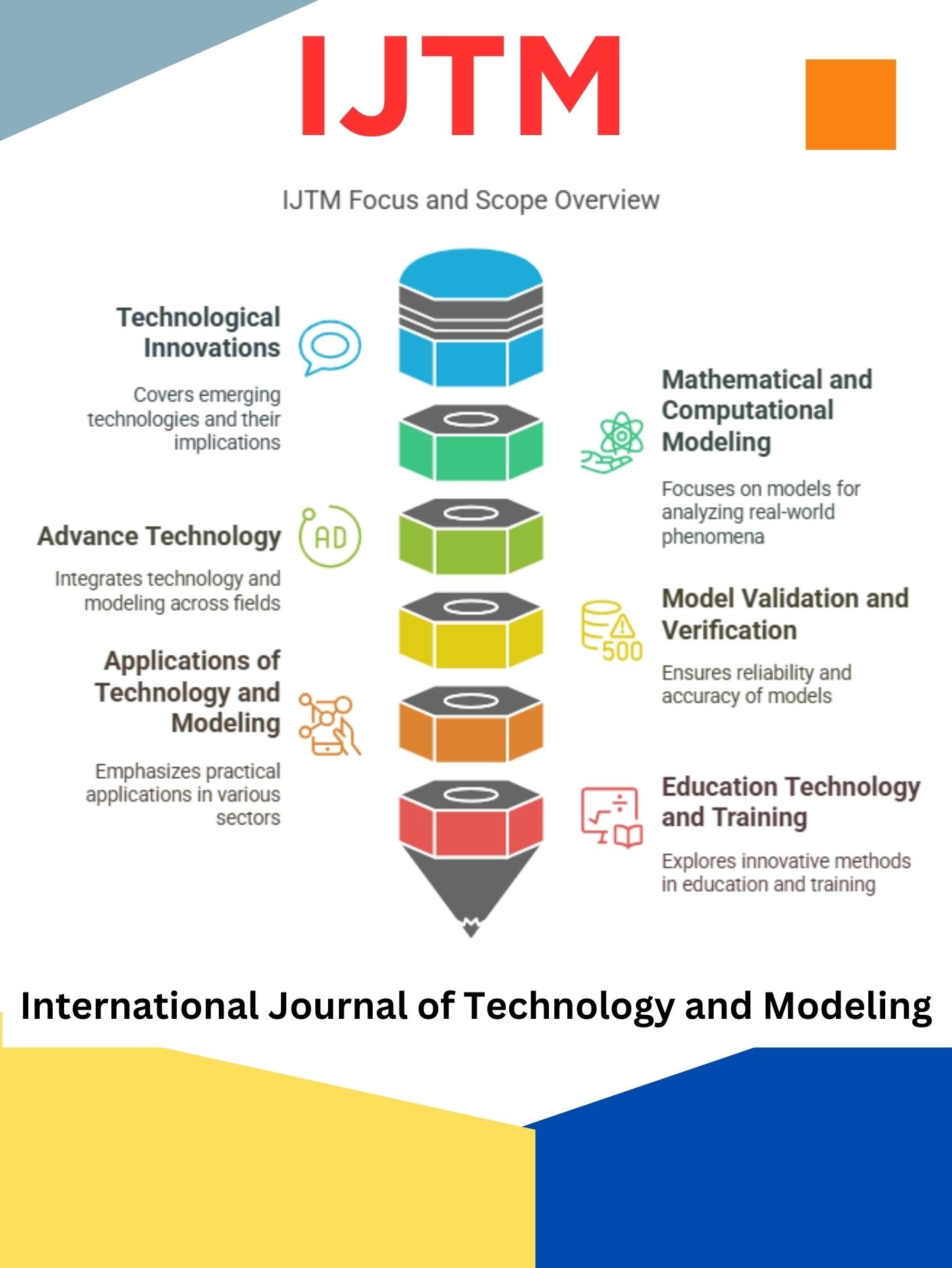Optimizing Supply Chains Through Technology and Computational Modeling
DOI:
https://doi.org/10.63876/ijtm.v4i2.138Keywords:
Supply Chain Optimization, Computational Modeling, Emerging Technologies, Logistics ManagementAbstract
In the era of rapid globalization, optimizing supply chains has become essential for enhancing operational efficiency and competitiveness. This study investigates the role of technology and computational modeling in improving supply chain performance in the context of Myanmar, a developing economy with unique logistical and infrastructural challenges. By integrating advanced technologies such as IoT, data analytics, and simulation-based modeling, the research evaluates their impact on demand forecasting, inventory management, and transportation planning. A case study approach involving key sectors such as agriculture and manufacturing was employed to assess real-world applicability. Results indicate significant improvements in supply chain responsiveness, cost reduction, and decision-making accuracy. This paper contributes to the growing body of knowledge by providing insights into how emerging technologies can be effectively applied in developing countries to overcome supply chain inefficiencies. The findings also highlight the importance of tailored technological adoption strategies that consider local socio-economic and infrastructural conditions.
Downloads
References
B. Ohene-Botwe et al., “Challenges and strategies for retaining Africa’s radiography workforce in the continent amidst a competitive global market: Insights from 17 countries,” Radiography, vol. 31, no. 4, p. 103001, Jul. 2025, doi: https://doi.org/10.1016/j.radi.2025.103001.
J.-C. Kim, S. Mazumder, A. Nejadmalayeri, and Q. Su, “Global competitiveness and market liquidity,” Glob. Financ. J., vol. 67, p. 101148, Sep. 2025, doi: https://doi.org/10.1016/j.gfj.2025.101148.
R. Y. Zhong, S. T. Newman, G. Q. Huang, and S. Lan, “Big Data for supply chain management in the service and manufacturing sectors: Challenges, opportunities, and future perspectives,” Comput. Ind. Eng., 2016, doi: https://doi.org/10.1016/j.cie.2016.07.013.
E. N. Volkov and A. N. Averkin, “Explainable Artificial Intelligence in Medical Image Analysis: State of the Art and Prospects,” in 2023 XXVI International Conference on Soft Computing and Measurements (SCM), IEEE, May 2023, pp. 134–137. doi: https://doi.org/10.1109/SCM58628.2023.10159033.
A. Sharma, M. Khokhar, Y. Duan, M. Bibi, R. Sharma, and B. Muhammad, “AI and sustainable business model innovation: A systematic literature review,” Sustain. Futur., vol. 10, p. 101204, Dec. 2025, doi: https://doi.org/10.1016/j.sftr.2025.101204.
Y. Liu and H. Wang, “Customer digitalization and supplier greenwashing,” J. Environ. Manage., vol. 393, p. 127142, Oct. 2025, doi: https://doi.org/10.1016/j.jenvman.2025.127142.
D. Dhaliwal, J. Shenoy, and R. Williams, “Common auditors and relationship-specific investment in supplier-customer relationships,” Br. Account. Rev., p. 101732, Jul. 2025, doi: https://doi.org/10.1016/j.bar.2025.101732.
T. Trinh and H. Zhao, “The effect of supplier CSR on customer–supplier relationship,” J. Bus. Res., vol. 185, p. 114909, Dec. 2024, doi: https://doi.org/10.1016/j.jbusres.2024.114909.
C. D. Bale, M. J. Schneider, and J. Lee, “Can we protect time series data while maintaining accurate forecasts?,” Int. J. Forecast., Sep. 2025, doi: https://doi.org/10.1016/j.ijforecast.2025.01.001.
O. J. Fisher, Y. Wang, and A. Ahmed, “Making waves: Transforming biofilm-based wastewater treatment using machine learning-driven real-time monitoring,” Water Res., vol. 287, p. 124491, Dec. 2025, doi: https://doi.org/10.1016/j.watres.2025.124491.
V. Kilis, N. Ploskas, and G. Panaras, “Investigation of multi-objective decision making approaches for the optimization in building envelope thermal design,” Sustain. Energy Technol. Assessments, vol. 82, p. 104506, Oct. 2025, doi: https://doi.org/10.1016/j.seta.2025.104506.
A. Razaque, S. Hariri, A. M. Alajlan, and J. Yoo, “A comprehensive review of cybersecurity vulnerabilities, threats, and solutions for the Internet of Things at the network-cum-application layer,” Comput. Sci. Rev., vol. 58, p. 100789, Nov. 2025, doi: https://doi.org/10.1016/j.cosrev.2025.100789.
D. G. Huong, M. Azmat, and R. Hadeed, “Exploring big data analytics adoption for sustainable manufacturing supply Chains: Insights from a TOE-guided systematic review,” Clean. Logist. Supply Chain, vol. 16, p. 100256, Sep. 2025, doi: https://doi.org/10.1016/j.clscn.2025.100256.
J. Rand, P. Castro Rodriguez, F. Tarp, and N. Trifkovic, “Economic and environmental upgrading after a policy reform: The case of timber value chain in Myanmar,” J. Rural Stud., vol. 99, pp. 20–34, Apr. 2023, doi: https://doi.org/10.1016/j.jrurstud.2023.02.008.
E. A. G. de Souza, T. Mlinar, M. Van den Broeke, and S. Creemers, “Dynamic programming in inventory management: A review,” Comput. Oper. Res., vol. 183, p. 107164, Nov. 2025, doi: https://doi.org/10.1016/j.cor.2025.107164.
S. Schiffels and C. Jost, “The role of scarcity behavior in inventory management,” Eur. J. Oper. Res., Jun. 2025, doi: https://doi.org/10.1016/j.ejor.2025.05.043.
D. Baccega et al., “Forge4Flame: An intuitive dashboard for designing GPU agent-based models to simulate infectious disease spread,” Simul. Model. Pract. Theory, vol. 145, p. 103205, Dec. 2025, doi: https://doi.org/10.1016/j.simpat.2025.103205.
A. Purwanto, S. Maesaroh, and A. Sulistyo, “Optimizing Supply Chain Management with Reinforcement Learning: A Data-Driven Approach,” Int. J. Technol. Model., vol. 1, no. 3, pp. 93–105, Dec. 2022, doi: https://doi.org/10.63876/ijtm.v1i3.113.
Z. Wang, X. Wang, H. Tao, H. Li, and Y. Rao, “China’s energy consumption trends and structural transition pathways under synergistic cost and carbon constraints: Based on the perspective of optimal steady economic growth,” Energy, vol. 335, p. 138246, Oct. 2025, doi: https://doi.org/10.1016/j.energy.2025.138246.
F. X. Pascual, K. L. Tan, and B. A. Ramos, “Modelling the Dynamics of Financial Markets: Insights from Agent-Based Models,” Int. J. Technol. Model., vol. 3, no. 1, pp. 35–45, Apr. 2024, doi: https://doi.org/10.63876/ijtm.v3i1.123.
M. Hart Nibbrig, S. Sharif Azadeh, and M. Y. Maknoon, “Adaptive resilience strategies for supply chain networks against disruptions,” Transp. Res. Part E Logist. Transp. Rev., vol. 200, p. 104172, Aug. 2025, doi: https://doi.org/10.1016/j.tre.2025.104172.
L. K. Alexis, “Avoiding Gender Determinism: Ivorian Women between Political Challenges and Economic Recognition,” Procedia - Soc. Behav. Sci., vol. 161, pp. 257–262, Dec. 2014, doi: https://doi.org/10.1016/j.sbspro.2014.12.067.
Zahra Rustiani Muplihah, Dede Nurohmah, Y. Marine, and R. Hidayat, “Population Dynamics Modeling with Differential Equation Method,” Int. J. Technol. Model., vol. 1, no. 3, pp. 78–85, Dec. 2022, doi: https://doi.org/10.63876/ijtm.v1i3.107.
H. Guo et al., “Analysis of thermal and mechanical properties with inventory level of the molten salt storage tank in central receiver concentrating solar power plants,” Appl. Therm. Eng., vol. 260, p. 124984, Feb. 2025, doi: https://doi.org/10.1016/j.applthermaleng.2024.124984.
A. Wooley, J. Bitencourt, and D. Silva, “Bridging the gap between discrete event simulation and digital twin: A manufacturing case study☆☆,” Manuf. Lett., vol. 44, pp. 1274–1284, Aug. 2025, doi: https://doi.org/10.1016/j.mfglet.2025.06.147.
V. Cherapanukorn, P. Pattanasak, and R. Wudhikarn, “Key performance indicators for sustainable business incubation: identification and prioritization,” Sustain. Futur., vol. 10, p. 101284, Dec. 2025, doi: https://doi.org/10.1016/j.sftr.2025.101284.



